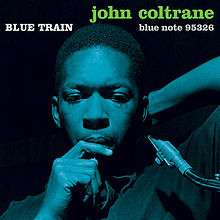Blue Train (album)
| Blue Train | ||||
|---|---|---|---|---|
 | ||||
| Studio album by John Coltrane | ||||
| Released | 1958 | |||
| Recorded |
September 15, 1957 Van Gelder Studio, Hackensack | |||
| Genre | Hard bop[1] | |||
| Length | 42:50 | |||
| Label |
Blue Note BLP 1577 | |||
| Producer | Alfred Lion | |||
| John Coltrane chronology | ||||
| ||||
| Professional ratings | |
|---|---|
| Review scores | |
| Source | Rating |
| Allmusic | |
| The Penguin Guide to Jazz | |
| The Rolling Stone Jazz Record Guide | |
Blue Train is a studio album by John Coltrane, released in 1958 on Blue Note Records, catalogue BLP 1577. Recorded at the Van Gelder Studio in Hackensack, New Jersey, it is the only Blue Note recording by Coltrane as the leader on the session. It has been certified a gold record by the RIAA.[5]
Background
The album was recorded in the midst of Coltrane's residency at the Five Spot as a member of the Thelonious Monk quartet. The personnel include Coltrane's Miles Davis bandmates, Paul Chambers on bass and Philly Joe Jones on drums, both of whom had worked before with pianist Kenny Drew. Both trumpeter Lee Morgan and trombonist Curtis Fuller were up-and-coming jazz musicians, and both would be members of Art Blakey's Jazz Messengers, working together on several of Blakey's albums.
All of the compositions were written by Coltrane, with the exception of the standard "I'm Old Fashioned". The title track is a long, rhythmically variegated blues with a sentimental [quasi minor; in fact based on major chords with flat tenth, or raised ninth] theme that gradually shows the major key during Coltrane's first chorus. "Locomotion" is also a blues riff tune, in forty-four-bar form.[6] During a 1960 interview, Coltrane described Blue Train as his favorite album of his own up to that point.[7]
Legacy
John Coltrane's next major album, Giant Steps, recorded in 1959, would break new melodic and harmonic ground in jazz, whereas Blue Train adheres to the hard bop style of the era. Two of its songs – "Moment's Notice" and "Lazy Bird" – demonstrate Coltrane's first recorded use of Coltrane changes, which he would later expand upon on Giant Steps. Musicologist Lewis Porter has also demonstrated a harmonic relationship between Coltrane's "Lazy Bird" and Tadd Dameron's "Lady Bird".[8]
In 1997, The Ultimate Blue Train was released, adding two alternate takes and enhanced content, and in 1999 a 24bit 192kHz DVD-Audio version was issued. In 2003, both a Super Audio Compact Disc version was released, as well as a remastered compact disc as part of Blue Note's Rudy Van Gelder series.
In 2015, Blue Note/Universal released a Blu-Ray Audio edition of the album with four bonus tracks, one of which is a previously unreleased take of "Lazy Bird".
Track listing
Side one
| No. | Title | Writer(s) | Length |
|---|---|---|---|
| 1. | "Blue Train" | John Coltrane | 10:43 |
| 2. | "Moment's Notice" | John Coltrane | 9:10 |
Side two
| No. | Title | Writer(s) | Length |
|---|---|---|---|
| 1. | "Locomotion" | John Coltrane | 7:14 |
| 2. | "I'm Old Fashioned" | Johnny Mercer, Jerome Kern | 7:58 |
| 3. | "Lazy Bird" | John Coltrane | 7:00 |
1997 bonus tracks
| No. | Title | Writer(s) | Length |
|---|---|---|---|
| 6. | "Blue Train" (alternate take) | John Coltrane | 9:58 |
| 7. | "Lazy Bird" (alternate take) | John Coltrane | 7:12 |
2014 Blue Note SHM-CD Remaster Edition (Japan Release)
| No. | Title | Writer(s) | Length |
|---|---|---|---|
| 1. | "Blue Train" | John Coltrane | 10:43 |
| 2. | "Moment's Notice" | John Coltrane | 9:10 |
| 3. | "Locomotion" | John Coltrane | 7:14 |
| 4. | "I'm Old Fashioned" | Johnny Mercer, Jerome Kern | 7:58 |
| 5. | "Lazy Bird" | John Coltrane | 7:00 |
| 6. | "Blue Train" (Alternate Take 1) | John Coltrane | 7:12 |
| 7. | "Blue Train" (Alternate Take 2) | John Coltrane | 9:58 |
| 8. | "Lazy Bird" (Alternate Take) | John Coltrane | 7:12 |
Personnel
- John Coltrane – tenor saxophone
- Lee Morgan – trumpet
- Curtis Fuller – trombone
- Kenny Drew – piano
- Paul Chambers – bass
- Philly Joe Jones – drums
References
- ↑ Cook 2004, p. 103.
- ↑ Blue Train at AllMusic
- ↑ Cook, Richard; Morton, Brian (2008). The Penguin Guide to Jazz Recordings (9th ed.). Penguin. p. 284. ISBN 978-0-141-03401-0.
- ↑ Swenson, J. (Editor) (1985). The Rolling Stone Jazz Record Guide. USA: Random House/Rolling Stone. p. 46. ISBN 0-394-72643-X.
- ↑ RIAA Gold and Platinum Search retrieved August 2, 2011 Archived June 26, 2007, at the Wayback Machine.
- ↑ Jazz Discography on-line
- ↑ Porter 1999, p. 157.
- ↑ Porter 1999, pp. 128-131.
Bibliography
- Cook, Richard (May 1, 2004). Blue Note Records: The Biography. Justin, Charles & Co. ISBN 1932112278.
- Porter, Lewis (1999). John Coltrane: His Life and Music. Ann Arbor: The University of Michigan Press. ISBN 0-472-10161-7.
External links
- Blue Train at Discogs (list of releases)